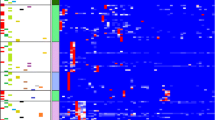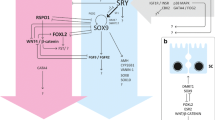Abstract
Purpose: Homeobox genes encode transcription factors that dictate developmental events in philogenetically diverse organisms. In comparison to what is known about their role in embryogenesis, we know very little concerning homeobox gene function in neonates or adults. In this communication, we review studies that address the possible role of homebox genes in male reproductive development, a system active in neonate and adult animals.
Methods: Studies have shown that many homeobox genes are expressed in germ cells of the testis, while less is known about the identity of homeobox genes expressed in somatic cells of the testis or epididymis. Hox homeobox genes display a pattern of expression in testis that is dependent on their paralogous and orthologous position within the Hox gene chromosome clusters. Other homeobox genes are expressed in the male reproductive system, including many POU and Prd/Pax homeobox gene family members. More recently, it has been shown that the orphan homeobox gene, Pem, originally isolated by subtraction hybridization on the basis of its differential expression in tumor cell lines, is selectively expressed in reproductive tissue. Alternatively spliced Pem transcripts accumulate in testis and epididymis that differ from those expressed in tumors and placenta. Pem transcripts accumulate postnatally in the epididymis in a developmentally regulated manner.
Conclusions: The highly regulated pattern of expression exhibited by many homeobox genes in the male reproductive system suggests that homeobox transcription factors may dictate developmental events in this system. However, future studies are needed to determine the specific functional roles of homeobox genes in male reproductive development and spermatogenesis.
Similar content being viewed by others
References
Lawrence HJ, Largman C: Homeobox genes in normal hematopoiesis and leukemia. Blood 1992;80:2445–2453
Scott MP: Vertebrate homeobox gene nomenclature. Cell 1992;71:551–553
Rubin MR, Toth LE, Patel MD, D'Eustachio P, Nguyen-Huu MC: A mouse homeobox gene is expressed in spermatocytes and embryos. Science 1986;233:663–667
Duboule D, Baron A, Mähl P, Galliot B: A new homeo-box gene is present in overlapping cosmid clones which define the mouse HOX-1 locus. EMBO J 1986;5:1973–1980
Wolgemuth DJ, Engelmyer E, Duggal RN, Gizang-Ginsberg E, Mutter GL, Ponzetto C, Viviano C, Zakeri ZF: Isolation of a mouse cDNA coding for a developmentally regulated, testis-specific transcript containing homeobox homology. EMBO J 1986;5:1229–1235
Wolgemuth DJ, Viviano CM, Gizang-Ginsberg E, Frohman MA, Joyner AL, Martin GR: Differential expression of the mouse homeobox-containing gene Hox-1.4 during male germ cells differentiation and embryonic development. Proc Natl Acad Sci USA 1987;84:5813–5817
Wolgemuth DJ, Viviano CM, Watrin F: Expression of homeobox genes during spermatogenesis. Ann NY Acad Sci 1991;637:300–312
Propst F, Rosenberg MP, Oskarsson MK, Russell LB, Nguyen-Huu MC, Nadeau J, Jenkins NA, Copeland NG, Vande Woude GF: Genetic analysis and developmental regulation of testis-specific RNA expression of Mos, Abl, actin and Hox-1.4. Oncogene 1988;2:227–233
Krumlauf R: Hox genes and pattern formation in the branchial region of the vertebrate head. Trends Genet 1993;9:106–111
Watrin F, Wolgemuth DJ: Conservation and divergence of patterns of expression and lineage-specific transcripts in orthologues and paralogues of the mouse Hox-1.4 gene. Dev Biol 1993;156:136–145
Featherstone MS, Baron A, Gaunt SJ, Mattei M-G, Duboule D: Hox-5.1 defines a homeobox-containing gene locus on mouse chromosome 2. Proc Natl Acad Sci USA 1988;85:4760–4764
Colberg-Poley AM, Voss SD, Chowdhury K, Stewart CL, Wagner EF, Gruss P: Clustered homeo boxes are differentially expressed during murine development. Cell 1985;43:39–45
Lowney P, Corral J, Detmer K, LeBeau MM, Deaven L, Lawrence HJ, Largman C: A human Hox 1 homeobox gene exhibits myeloid-specific expression of alternative transcripts in human hematopoietic cells. Nucelic Acids Res 1991;19:3443–3449
Baron A, Featherstone MS, Hill RE, Hall A, Galliot B, Duboule D: Hox-1.6: A mouse homeo-box-containing gene member of the Hox-1 complex. EMBO J 1987;6:2977–2986
Odenwald WF, Taylor CF, Palmer-Hill FJ, Friedrich V Jr., Tani M, Lazzarini RA: Expression of a homeo domain protein in noncontact-inhibited cultured cells and postmitotic neurons. Genes Dev 1987;1:482–496
Meijlink F, de Laaf R, Verrijzer P, Destrée O, Kroezen V, Hilkens J, Deschamps J: A mouse homeobox containing gene on chromosome 11: Sequence and tissue-specific expression. Nucleic Acids Res 1987;15:6773–6786
Le Mouellic H, Lallemand Y, Brûlet P: Homeosis in the mouse induced by a null mutation in the Hox-3.1 gene. Cell 1992;69:251–264
Sharpe PT, Miller JR, Evans EP, Burtenshaw MD, Gaunt SJ: Isolation and expression of a new mouse homeobox gene. Development 1988;102:397–407
Robertson M: Homeo boxes, POU proteins and the limits to promiscuity. Nature 1988;336:522–524
Suzuki N, Rohdewohld H, Neuman T, Gruss P, Schöler HR: Oct-6: A POU transcription factor expressed in embryonal stem cells and in the developing brain. EMBO J 1990;9:3723–3732
Schöler HR, Hatzopoulos AK, Balling R, Suzuki N, Gruss P: A family of octamer-specific proteins present during mouse embryogenesis: Evidence for germline-specific expression of an Oct factor. EMBO J 1989;8:2543–2550
He X, Treacy MN, Simmons DM, Ingraham HA, Swanson LW, Rosenfeld MG: Expression of a large family of POU-domain regulatory genes in mammalian brain development. Nature 1989;340:35–42
Monuki ES, Weinmaster G, Kuhn R, Lemke G: SCIP: A glial POU domain gene regulated by cyclic AMP. Neuron 1989;3:783–793
Meijer D, Graus A, Kraay R, Langeveld A, Mulder MP, Grosveld G: The octamer binding factor Oct6: cDNA cloning and expression in early embryonic cells. Nucleic Acids Res 1990;18:7357–7362
Rosner MH, Vigano MA, Ozato K, Timmons PM, Poirier F, Rigby PWJ, Staudt LM: A POU-domain transcription factor in early stem cells and germ cells of the mammalian embryo. Nature 1990;345:686–691
MacLeod CL, Fong AM, Seal BS, Walls L, Wilkinson MF: Isolation of novel complementary DNA clones from T lymphoma cells: One encodes a putative multiple membrane-spanning protein. Cell Growth Diff 1990;1:271–279
Sasaki AW, Doskow J, MacLeod CL, Rogers MB, Rogers LJ, Wilkinson MF: The oncofetal gene Pem encodes a homeodomain and is regulated in primordial and pre-muscle stem cells. Mech Dev 1991;34:155–164
Rayle RE: The oncofetal gene Pem specifies a divergent paired class homeodomain. Dev Biol 1991;146:255–257
Wilkinson MF, Kleeman J, Richards J, MacLeod CL: A novel oncofetal gene is expressed in a stage-specific manner in murine embryonic development. Dev Biol 1990;141:451–455
Wilkinson M: Purification of RNA.In Essential Molecular Biology: A practical approach, TA Brown (eds). New York, Oxford University Press, 1991, pp 69–88
Zinn K, DiMaio D, Maniatis T: Identification of two distinct regulatory regions adjacent to the humanβ-interferon gene. Cell 1983;34:865–879
Propst F, Rosenberg MP, Vande Woude GF: Proto-oncogene expression in germ cell development. Trends Genet 1988;4:183–187
Garrett JE, Collard MW, Douglass JO: Translational control of germ cell-expressed mRNA imposed by alternative splicing: Opioid peptide gene expression in rat testis. Mol Cell Biol 1989;9:4381–4389
Adams B, Dörfler P, Aguzzi A, Kozmik Z, Urbánek P, Maurer-Fogy I, Busslinger M: Pax-5 encodes the transcription factor BSAP and is expressed in Blymphocytes, the developing CNS, and adult testis. Genes Dev 1992;6:1589–1607
Kern MJ, Witte DP, Valerius MT, Aronow BJ, Potter SS: A novel murine homeobox gene isolated by a tissue specific PCR cloning strategy. Nucleic Acids Res 1992;20:5189–5195
Zannini M, Francis-Lang H, Plachov D, Lauro RD: Pax-8, a paired domain-containing protein, binds to a sequence overlapping the recognition site of a homeodomain and activates transcription from two thyroid-specific promoters. Mol Cell Biol 1992;12:4230–4241
Komuro I, Schalling M, Jahn L, Bodmer R, Jenkins NA, Copeland NG, Izumo S: Gtx: A novel murine homeobox-containing gene, expressed specifically in glial cells of the brain and germ cells of testis, has transcriptional repressor activity in vitro for a serum-inducible promoter. EMBO J 1993;12:1387–1401
Asnao M, Emori Y, Saigo K, Shiokawa K: Isolation and characterization of a Xenopus cDNA which encodes a homeodoman highly homologous to Drosophila Distal-less. J Biol Chem 1992;267:5044–5047
Bieberich CJ, Utset MF, Awgulewitsch A, Ruddle FH: Evidence for positive and negative regulation of the Hox-3.1 gene. Proc Natl Acad Sci USA 1990;87:8462–8466
Ramirez-Solis R, Zheng H, Whiting J, Krumlauf R, Bradley A: Hoxb-4 (Hox-2.6) mutant mice show homeotic transformation of a cervical vertebra and defects in the closure of the sternal rudiments. Cell 1993;73:279–294
Chisaka O, Capecchi MR: Regionally restricted developmental defects resulting from targeted disruption of the mouse homeobox gene hox-1.5. Nature 1991;350:473–479
Jegalian BG, De Robertis EM: Homeotic transformations in the mouse-induced by overexpression of a human Hox3.3 transgene. Cell 1992;71:901–910
Lufkin T, Mark M, Hart CP, Dollé P, LeMeur M, Chambon P: Homeotic transformation of the occipital bones of the skull by ectopic expression of a homeobox gene. Nature 1992;359:835–841
Moore HDM, Hartman TD, Smith CA: In-vitro culture of hamster epididymal epithelium and induction of sperm motility. J Reprod Fert 1986;78:327–336
Jones FS, Prediger EA, Bittner DA, DeRobertis EM, Edelman GM: Cell adhesion molecules as targets for Hox genes: Neural cell adhesion molecule promoter activity is modulated by co-transfection with Hox-2.5 and -2.4. Proc Natl Acad Sci USA 1992;89:2086–2090
Marziali G, Lazzaro D, Sorrentino V: Binding of germ cells to mutant SId Sertoli cells is defective and is rescued by expression of the transmembrane form of the c-kit ligand. Dev Biol 1993;157:182–190
Cyr DG, Robaire B: Developmental regulation of epithelial- and placental-cadherin mRNAs in the rat epididymis. Ann NY Acad of Sci 1991;637:399–408
Erickson HP: Gene knockouts of c-src. transforming growth factorβ1, and tenascin suggest superfluous, nonfunctional expression of proteins. J Cell Biol 1993;120:1079–1081
Joyner AL, Herrup K, Auerbach BA, Davis CA, Rossant J: Subtle cerebellar phenotype in mice homozygous for a targeted deletion of the En-2 homeobox. Science 1991;251:1239–1243
Author information
Authors and Affiliations
Rights and permissions
About this article
Cite this article
Lindsey, S., Wilkinson, M.F. Homeobox genes and male reproductive development. J Assist Reprod Genet 13, 182–192 (1996). https://doi.org/10.1007/BF02072542
Received:
Accepted:
Issue Date:
DOI: https://doi.org/10.1007/BF02072542




